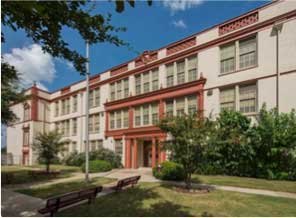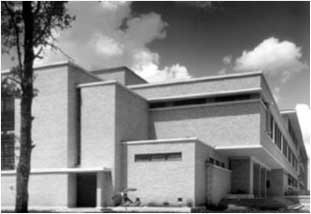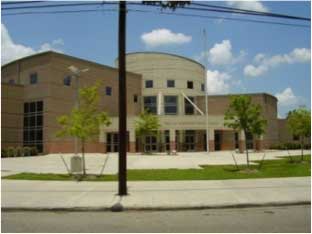Phillis Wheatley Alumni Association
Phillis Wheatley High School opened its doors in 1927 as a secondary school (grades 7-11 or 12) in the Houston Independent School District (HISD) for the education of Black American students residing in the Northeast Quadrant of Houston. Classes began in what had been all-white McGowan Elementary School located at 3415 Lyons Avenue. Almost immediately, Wheatley became one of the largest Black American high schools in the U.S. with 2,600 students and 60 teachers. Through the years of its growth, it transformed into what is thought of today as a high school (grades 9-12) with the remaining grades (7 and 8) ultimately merged with the 6th grade into what eventually became E. O. Smith Middle School. The Wheatley campuses, after 1927, progressed as follows: first to 1700 Gregg Street in 1929 on the same property originally occupied by the old McGowan Elementary School; then to 4900 Market Street in 1950 with the 1700 Gregg Street campus becoming first E. O. Smith Junior High School and later E. O. Smith Middle School; and, finally, to 4801 Providence Street in 2006 on the same property occupied by the 4900 Market Street campus. The current 2006 campus has the unique distinction of having a Wheatley graduate (Class of 1956), Willie C. Jordan, as its architect.
Although, in 1954, the U. S. Supreme Court overturned separate but equal schools for Blacks and Whites, it was not until 1956 that HISD attempted to comply
Although, in 1954, the U. S. Supreme Court overturned separate but equal schools for Blacks and Whites, it was not until 1956 that HISD attempted to comply as the result of a suit filed by the Houston Chapter of the NAACP in which one of the two plaintiffs, Beneva Willliams Nyamu, became a 1960 graduate of Phillis Wheatley High School. The suit started the integration process in Houston; however, it took the staging of boycotts, protests, and marches in the mid-1960s, in which Wheatley student activists took part and even helped to lead, to force the eventual reality of the integration of Houston’s schools.
The period from 1927 to the end of the 1960s has come to be known as the “glory years” in the history and legacy of Phillis Wheatley High School wherein it attained an incredible record of accomplishments and recognitions, many of which go unrecognized even today. Much credit for the outcomes of this period must be attributed to the quality of the faculty members, recruited by the early principals, who inspired their students to achieve in a nurturing
environment that they created. There were numerous sports championships, especially in football, basketball, and track and field; award-winning musical and performing groups; outstanding students and athletes who were recruited by major universities, even in the Ivy League; and more than 60% of the graduating seniors enrolling in college. Many of these faculty members had graduate degrees, and some were elevated to administrative positions in HISD even after integration occurred.
Once integration occurred in the late 1960s, stresses of all sorts were placed on Wheatley, as well as other similar high schools, that destroyed its extraordinary competitive environment. Through various plans implemented by HISD that carried designations such as “crossover” and “busing,” as well as the development of the “magnet school” concept, Wheatley began to lose its luster as a powerhouse of accomplishments and excellence even after having produced and while continuing to produce some of the most productive and influential professionals at the local, state, and national levels: artists, musicians, professional athletes, architects, engineers, ministers, educators, university professors and presidents, entrepreneurs, corporate managers, social workers, health professionals, entertainers, and accomplished military veterans, to name just a few. In fact, some of the best known politicians, past and present, to serve at all levels of government (local, state, and national) have been Wheatley graduates.
As society has changed, so has Phillis Wheatley High School. Although still considered a minority inner-city high school, its population and demographics have changed as the population in the communities that support it, like the Historic Fifth Ward and Denver Harbor, have changed. The current student population is almost half Hispanic with the influx of many students from other countries that have settled in the supporting communities. As of 2019, the updated school population is now being challenged by student performance issues, leadership issues, faculty and administrative staff in constant flux, a toxic learning culture, and Texas HB1842. Today’s question is: Will Wheatley survive? The answer is: Yes it will by returning to many of its “glory-year” values with the help of an informed and dedicated alumni and supportive community efforts.
The Principals and Campuses of Phillis Wheatley High School
1927-1945
Ernest Ollington Smith

1929 Campus – 1700 Gregg Street
1945-1958
John Elihue Codwell, Sr.

1950 Campus – 4900 Market Street
1958-1971
William “Bill” Moore
1971-1978
Aerocolus Clyde Herald
1978-1983
Charles Herbert
1983-1989
Forest Thomas Henry, Jr.
1989-1992
Eddie Orum, III
1992-1994
Harold Crawford
1994-1999
Horace Williams
1999-2000
Charles Herbert (Interim)
2000-2006
Bruce Goffney

2006 Campus – 4801 Providence Street
2006-2010
Wiley Johnson
2010-2013
David Edgerson
2013
Ronald Rodriguez
2014-2018
Shirley Rose-Gilliam
2018-2022
Joseph Williams
2022-Present
